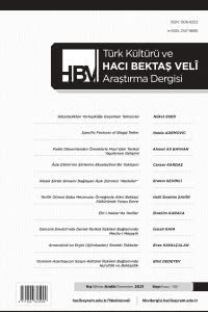EHL-İ HAKK GELENEĞİ İÇİN SHĀHNĀMIH-YI HAQĪQAT'IN ÖNEMİ
Ehl-i hak, Shāhnāmih-yi Ḥaqīqat, Ḥājj Niʿmatullāh, Dini Kimlik, Kolektif Kimlik
THE SIGNIFICANCE OF SHĀHNĀMIH-YI ḤAQĪQAT FOR THE AHL-I ḤAQQ TRADITION
Ahl-i Ḥaqq, Shāhnāmih-yi Ḥaqīqat, Ḥājj Niʿmatullāh, Religious Identity, Collective Identity,
___
- Arnett, J. J. A theory of development from the late teens through the twenties. American Psychologist, 55(5), 469-480, 2000.
- Atābakī, T. Persia/Iran. In U. Daniel, P. Gatrell, O. Janz, H. Jones, J. Keene, A. Kramer, & B. Nasson (Eds.), 1914-1918-Online; International Encyclopedia of the First World War. Freie Universität Berlin, 2016. https://doi.org/10.15463/ie1418.10899
- Drisko, J. W.,-Maschi, T. Content Analysis-(Pocket Guide to Social Work Research Methods). Oxford University Press, 2015.
- During, J. A critical survey on Ahl-i Ḥaqq studies in Europe and Iran. In T. Olsson, E. Özdalga, & C. Raudvere (Eds.), Alevi Identity: Cultural, Religious and Social Perspectives, 105-126, Curzon Press 1998.
- During, J. L'âme des sons; L’art unique d’Ostad Elahi. RELIÉ, 2001.
- Eisenstadt, S. N.,-Giesen, B. The construction of collective identity. European Journal of Sociology/Archives Européennes de Sociologie/Europäisches Archiv Für Soziologie, 36(1), 72-102, 1995.
- Elahi, N. A. Burhān ul-Ḥaqq. Jiyḥūn Publishing. (1994).
- Elahi, N. A. thār ul- Ḥaqq (B. Elahi, Ed. Vol. 1). Panj Publishing, 2007a.
- Elahi, N. A. Knowing the Spirit (Maʿrifat ul-Rūḥ) (J. W. Morris, Trans.). State University of New York Press, 2007b.
- Etengoff, C.,-Rodriguez, E. M. Religious Identity. In S. Hupp & J. D. Jewell (Eds.), The Encyclopedia of Child and Adolescent Development. Wiley-Blackwell, 2023.
- Filonik, J.,-Kucharski, J. Discourses of Identity in the Ancient World: Preliminary Remarks. Polis: The Journal for Ancient Greek and Roman Political Thought, 38(1), 1-5, 2021. https://doi. org/10.1163/20512996-12340304
- Huart, C. ʿAlī Ilāhī. In M. T. Houtsma, T. W. Arnold, R. Basset, & R. Hartmann (Eds.), Encyclopaedia of Islam, First Edition (1913-1936). Brill Publishers, 2012. https://doi.org/10.1163/2214-871X_ei1_ SIM_0636
- Jamshīdī, M. Qaḥṭī-yi buzurg-i sālhā-yi 1917–1919, 2015. https://www.iichs.ir/en/news/1600/the-greatfamine- 1917-1919
- Jedlowski, P. Memory and Sociology: Themes and Issues. Time & Society, 10(1), 29-44, 2001.
- Jiyḥūn-ābādī, N. Shāhnāmih-yi Ḥaqīqat. Jiyḥūn Publishing, 1994.
- Jones, R. Ibrāhīm b. Adham. In P. Bearman, T. Bianquis, C. E. Bosworth, E. v. Donzel,-W. P. Heinrichs (Eds.), Encyclopaedia of Islam, Second Edition. Brill Publishers, 2012.
- Klein, K. L. On the Emergence of Memory in Historical Discourse. Representations, 69, 127-150, 2000.
- Majd, M. G. Victorian Holocaust_ Iran in the Great Famine of 1869-1873. University Press of America, 2017.
- Majlisī, M. B. Baḥar al-Anvār. In (Vol. 35, 8). Dar al-Aḥyā al-Tarāth, 1983.
- Membrado, M. Ahl-i Ḥaqq Consecrated Families (khāndān). In C. Mayeur-Jaouen & A. Papas (Eds.), Family Portrait with Saints, 220–253, Klaus Schwarz-Ehess, 2013.
- Membrado, M. Ḥāj Niʿmatullāh Jiyḥūn-ābādī (1871–1920) and His Mystical Path Within the Ahl-e Ḥaqq Order. In K. ʿUmarkhālī (Ed.), Religious Minorities in Kurdistān: Beyond the Mainstream. Vol. 68, 13-45, Harrassowitz, 2014.
- Membrado, M. From Oral to Scriptural Transmission: The literary production of the Ahl-i Ḥaqq in the modern era. In R. Chih, D. Gril, C. Mayeur-Jaouen, & R. Seesemann (Eds.), Sufism, Literary Production and Printing in the Nineteenth Century, 139-187, Ergon Verlag, 2015.
- Minorsky, V. Notes sur la secte des Ahl-i Ḥaqq. Revue du Monde Musulman, 46, 1920.
- Minorsky, V. Ahl-i Ḥaḳḳ. In P. Bearman, T. Bianquis, C. E. Bosworth, E. v. Donzel,-W. P. Heinrichs (Eds.), Encyclopaedia of Islam, Second Edition, 260-263, Brill Publishers, 1960. http://dx.doi. org/10.1163/1573-3912_ei3_COM_2284
- Smith, A. D. Ethnic myths and ethnic revivals. European Journal of Sociology/Archives Européennes de Sociologie/Europäisches Archiv Für Soziologie, 25 (2), 283-305, 1984.
- Tammes, P.,-Scholten, P. Assimilation of Ethnic-Religious Minorities in the Netherlands: A Historical- Sociological Analysis of Pre–World War II Jews and Contemporary Muslims. Social Science History, 41 (3), 477-504, 2017. https://www.jstor.org/stable/90017922
- van Bruinessen, M. Veneration of Satan among the Ahl-e Ḥaqq of the Gûrân region. Fritillaria Kurdica, Bulletin of Kurdish Studies, 3-4, 6-41, 2014.
- ISSN: 1306-8253
- Yayın Aralığı: 4
- Başlangıç: 1994
- Yayıncı: Ankara Hacı Bayram Veli Üniversitesi Türk Kültürü Açısından Hacı Bektaş-ı Veli Araştırmaları Uygulama ve Araştırma Merkezi
CANER IŞIK, ALEVÎ ERENLER GELENEĞİ
SEYİT RIZA MİLLETLER CEMİYETİ’YLE BİRLEŞİK KRALLIK’TAN YARDIM İSTEDİ Mİ?
XOJA AHMAD YASSAVİY: UMRING YELDEK O’TARO, HIKMATLAR
HZ. ALİ VE MUÂVİYE’NİN HZ. OSMAN’IN KATLİNDE DAHLİ OLANLARA KARŞI TUTUMU
M. Hanefi PALABIYIK, Talha ÖZDEMİR
HÂŞİMÎ EMÎR OSMAN’IN TASAVVUFİ ADAP VE ERKÂNA DAİR GÖRÜŞLERİ
Abdülmecit İSLAMOĞLU, Merve GÜVEN
HALK EĞİTİMİNDE BİR ÖNCÜ: HACI BEKTAŞ VELİ
BATUMLU YESÂRÎ’NİN BİR MECMUADA BULUNAN YENİ ŞİİRLERİ
YARSAN EDEBİYATINDA KADIN ŞAİRLERİN YERİ
KAYNAKLAR IŞIĞINDA BURSA’DA BİR HORASAN ERENİ: ABDAL MURAD SULTAN, TÜRBE VE TEKKESİ
